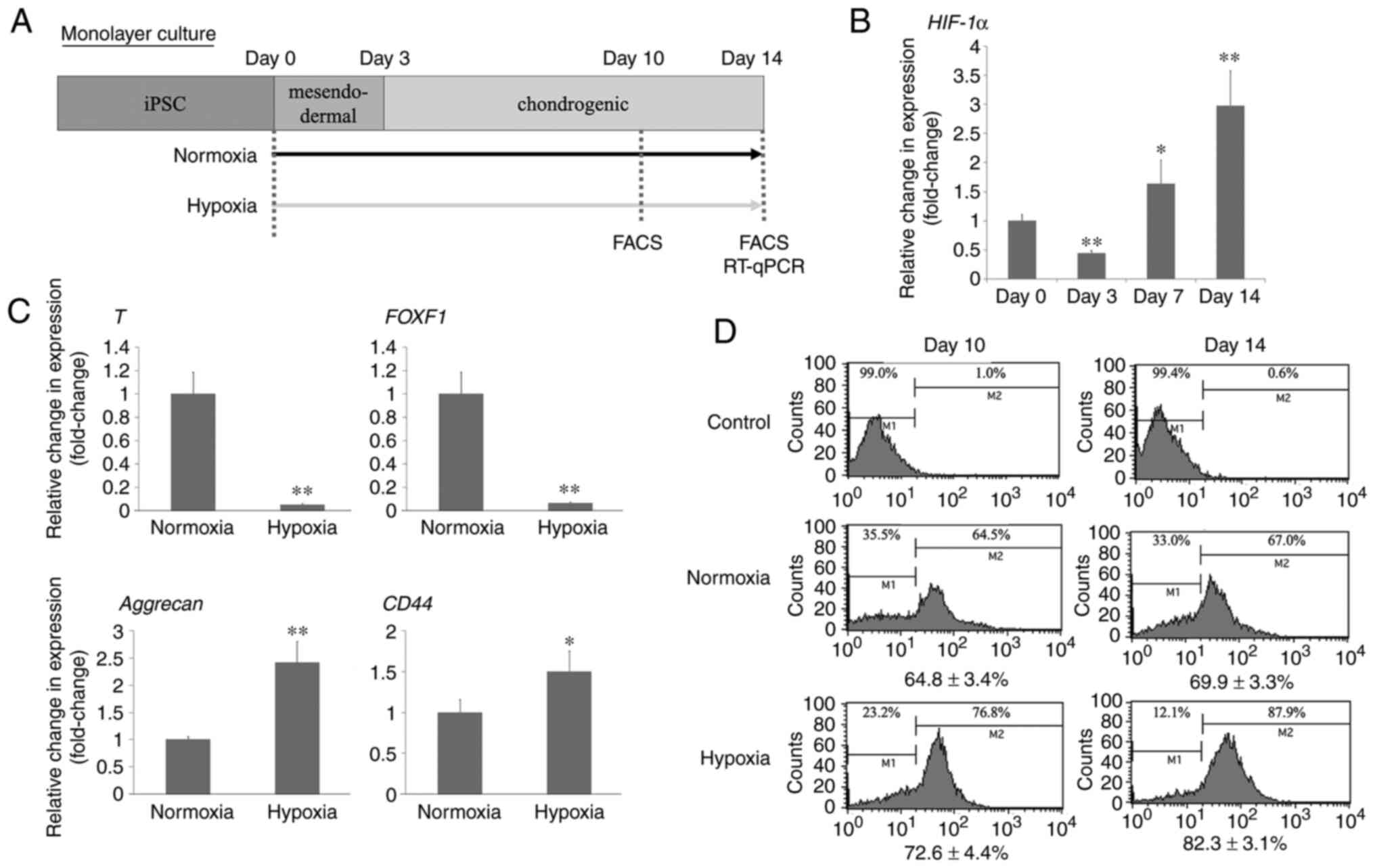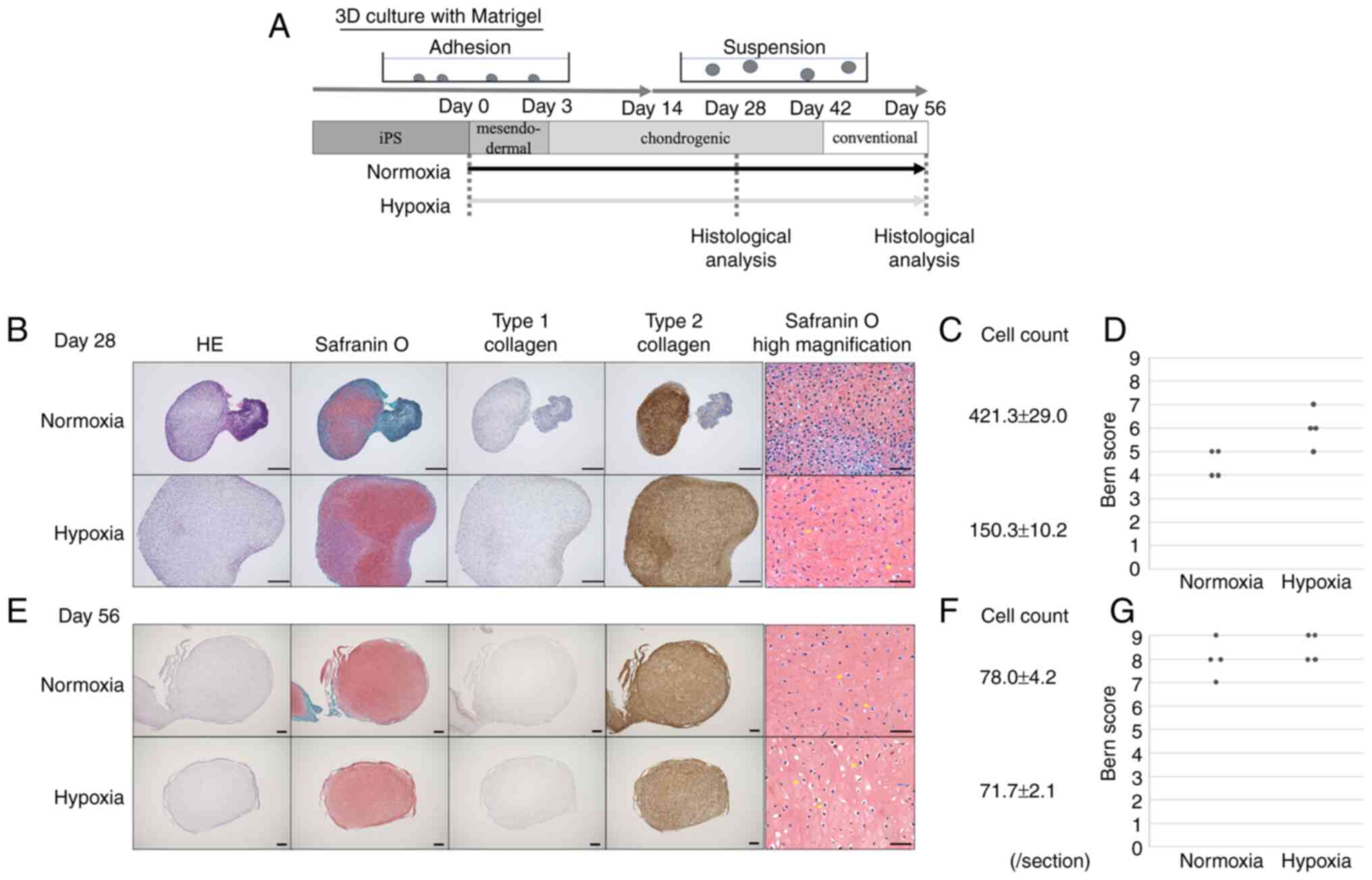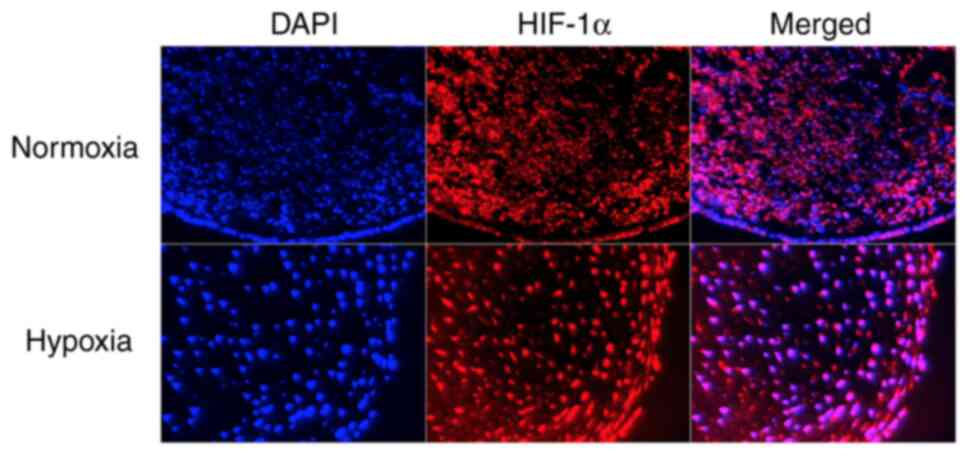|
1
|
Roberts S, Menage J, Sandell LJ, Evans EH
and Richardson JB: Immunohistochemical study of collagen types I
and II and procollagen IIA in human cartilage repair tissue
following autologous chondrocyte implantation. Knee. 16:398–404.
2009. View Article : Google Scholar : PubMed/NCBI
|
|
2
|
Driessen BJH, Logie C and Vonk LA:
Cellular reprogramming for clinical cartilage repair. Cell Biol
Toxicol. 33:329–349. 2017. View Article : Google Scholar
|
|
3
|
Chen YS, Pelekanos RA, Ellis RL, Horne R,
Wolvetang EJ and Fisk NM: Small molecule mesengenic induction of
human induced pluripotent stem cells to generate mesenchymal
stem/stromal cells. Stem Cells Transl Med. 1:83–95. 2012.
View Article : Google Scholar : PubMed/NCBI
|
|
4
|
Guzzo RM, Gibson J, Xu RH, Lee FY and
Drissi H: Efficient differentiation of human iPSC-derived
mesenchymal stem cells to chondroprogenitor cells. J Cell Biochem.
114:480–490. 2013. View Article : Google Scholar : PubMed/NCBI
|
|
5
|
Nejadnik H, Diecke S, Lenkov OD, Chapelin
F, Donig J, Tong X, Derugin N, Chan RC, Gaur A, Yang F, et al:
Improved approach for chondrogenic differentiation of human induced
pluripotent stem cells. Stem Cell Rev Rep. 11:242–253. 2015.
View Article : Google Scholar : PubMed/NCBI
|
|
6
|
Teramura T, Onodera Y, Takehara T,
Frampton J, Matsuoka T, Ito S, Nakagawa K, Miki Y, Hosoi Y,
Hamanishi C and Fukuda K: Induction of functional mesenchymal stem
cells from rabbit embryonic stem cells by exposure to severe
hypoxic conditions. Cell Transplant. 22:309–329. 2013. View Article : Google Scholar
|
|
7
|
Umeda K, Zhao J, Simmons P, Stanley E,
Elefanty A and Nakayama N: Human chondrogenic paraxial mesoderm,
directed specification and prospective isolation from pluripotent
stem cells. Sci Rep. 2:4552012. View Article : Google Scholar : PubMed/NCBI
|
|
8
|
Yamashita A, Morioka M, Yahara Y, Okada M,
Kobayashi T, Kuriyama S, Matsuda S and Tsumaki N: Generation of
scaffoldless hyaline cartilaginous tissue from human iPSCs. Stem
Cell Reports. 4:404–418. 2015. View Article : Google Scholar : PubMed/NCBI
|
|
9
|
Brown PT, Handorf AM, Jeon WB and Li WJ:
Stem cell-based tissue engineering approaches for musculoskeletal
regeneration. Curr Pharm Des. 19:3429–3445. 2013. View Article : Google Scholar : PubMed/NCBI
|
|
10
|
Schipani E, Ryan HE, Didrickson S,
Kobayashi T, Knight M and Johnson RS: Hypoxia in cartilage:
HIF-1alpha is essential for chondrocyte growth arrest and survival.
Genes Dev. 15:2865–2876. 2001. View Article : Google Scholar : PubMed/NCBI
|
|
11
|
Koay EJ and Athanasiou KA: Hypoxic
chondrogenic differentiation of human embryonic stem cells enhances
cartilage protein synthesis and biomechanical functionality.
Osteoarthritis Cartilage. 16:1450–1456. 2008. View Article : Google Scholar : PubMed/NCBI
|
|
12
|
Grogan SP, Barbero A, Winkelmann V, Rieser
F, Fitzsimmons JS, O'Driscoll S, Martin I and Mainil-Varlet P:
Visual histological grading system for the evaluation of in
vitro-generated neocartilage. Tissue Eng. 12:2141–2149. 2006.
View Article : Google Scholar : PubMed/NCBI
|
|
13
|
Hirano K, Konagaya S, Turner A, Noda Y,
Kitamura S, Kotera H and Iwata H: Closed-channel culture system for
efficient and reproducible differentiation of human pluripotent
stem cells into islet cells. Biochem Biophys Res Commun.
487:344–350. 2017. View Article : Google Scholar : PubMed/NCBI
|
|
14
|
Hwang GH, Park SM, Han HJ, Kim JS, Yun SP,
Ryu JM, Lee HJ, Chang W, Lee SJ, Choi JH, et al: Purification of
small molecule-induced cardiomyocytes from human induced
pluripotent stem cells using a reporter system. J Cell Physiol.
232:3384–3395. 2017. View Article : Google Scholar
|
|
15
|
Silver IA: Measurement of pH and ionic
composition of pericellular sites. Philos Trans R Soc Lond B Biol
Sci. 271:261–272. 1975. View Article : Google Scholar
|
|
16
|
Leijten J, Georgi N, Moreira Teixeira L,
van Blitterswijk CA, Post JN and Karperien M: Metabolic programming
of mesenchymal stromal cells by oxygen tension directs chondrogenic
cell fate. Proc Natl Acad Sci USA. 111:13954–13959. 2014.
View Article : Google Scholar : PubMed/NCBI
|
|
17
|
Amarilio R, Viukov SV, Sharir A,
Eshkar-Oren I, Johnson RS and Zelzer E: HIF1alpha regulation of
Sox9 is necessary to maintain differentiation of hypoxic
prechondrogenic cells during early skeletogenesis. Development.
134:3917–3928. 2007. View Article : Google Scholar
|
|
18
|
Sanz-Ramos P, Mora G, Vicente-Pascual M,
Ochoa I, Alcaine C, Moreno R, Doblaré M and Izal-Azcárate I:
Response of sheep chondrocytes to changes in substrate stiffness
from 2 to 20 Pa: Effect of cell passaging. Connect Tissue Res.
54:159–166. 2013. View Article : Google Scholar : PubMed/NCBI
|
|
19
|
Ginouvès A, Ilc K, Macías N, Pouysségur J
and Berra E: PHDs overactivation during chronic hypoxia
‘desensitizes’ HIFalpha and protects cells from necrosis. Proc Natl
Acad Sci USA. 105:4745–4750. 2008. View Article : Google Scholar
|
|
20
|
Tsuchida S, Arai Y, Takahashi KA, Kishida
T, Terauchi R, Honjo K, Nakagawa S, Inoue H, Ikoma K, Ueshima K, et
al: HIF-1α-induced HSP70 regulates anabolic responses in articular
chondrocytes under hypoxic conditions. J Orthop Res. 32:975–980.
2014. View Article : Google Scholar : PubMed/NCBI
|

















